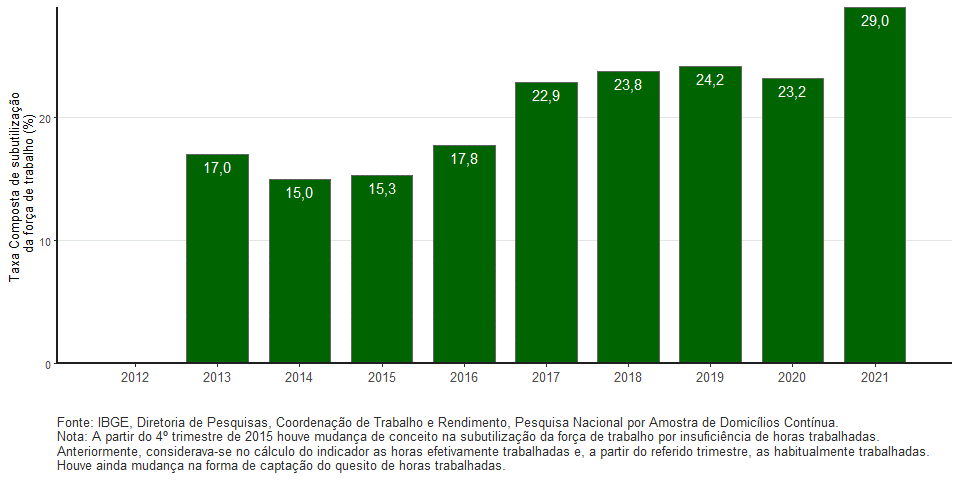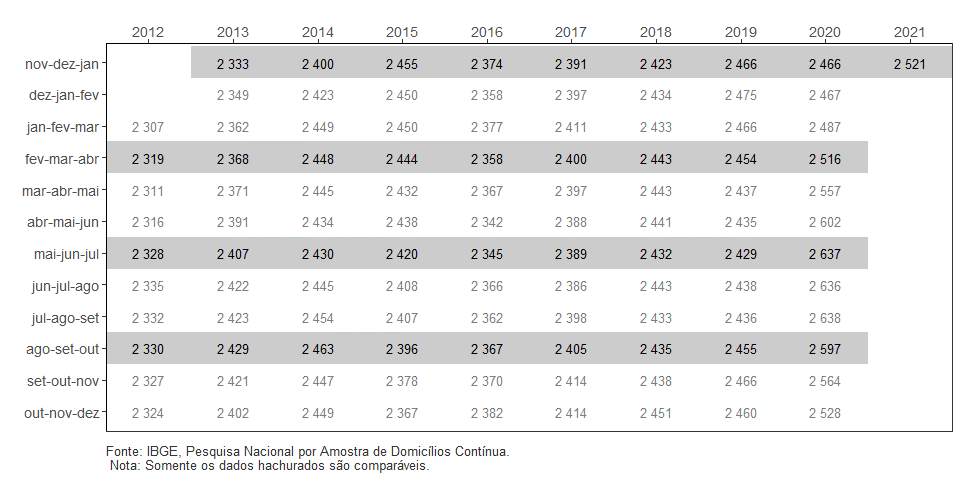Continuous PNAD: unemployment rate is 14.2% and underutilization rate, 29.0% in quarter ended January 2021
March 31, 2021 09h00 AM | Last Updated: April 05, 2021 12h32 PM
Unemployment rate in Brazil (14.2%) for there moving quarter November 2020-January 2021 leveled off from August-October 2020 (14.3%) and increased by 3.0 percentage points from the same period in 2020 (11.2%).
| Indicator/Period | Nov-Dec-Jan 2021 | Aug-Sep-Oct 2020 | Nov-Dec-Jan 2020 |
|---|---|---|---|
| Unemployment rate | 14.2% | 14.3% | 11.2% |
| Underutilization rate | 29.0% | 29.5% | 23.2% |
| Average real earnings | R$2,521 | R$2,597 | R$2,466 |
| Change of usual earnings in relation to: | -2.9% | 2.2% | |
The unemployed population (14.3 million persons) leveled off from August-October 2020 (14.1 million persons). Against the same quarter a year ago (11.9 million persons) there was an increase by 19.8% (a total 2.4 million unemployed persons.
The employed population (86.0 million persons) increased by 2.0% (1.7 million pessoas more) from the previous quarter and recorded a decrease of 8.6% from the same quarter a year ago (8.1 million persons less).
Employment population ratio (percentage of employment personas in the population at working age) reached 48.7%, and increased by 0.7 percentage points from the previous quarter (48.0%) with a decrease by 6.1 p.p. against the same quarter a year ago (54.8%).
The compound underutilization rate (29.0%) fell 0.5 p.p. from the quarter August-October 2020 (29.5%) and increased by 5.9 p.p. from the same quarter in 2020 (23.2%).
The underutilized population (32.4 million persons) remained durable against the previous months and increased by 22.7% (6.0 million persons more) versus 2020.
The population out of the workforce (76.4 million persons) fell by 1,1% (817 thousand persons) from the preceding quarter and increased 16.2% (10.6 million persons) from the same quarter in 2020.
The discouraged population (5.9 million persons) leveled off from the previous quarter and was 25.6% above the figure for the same period in 2020. The percentage of discouraged ones in workforce or discouraged population (5.6%) remunera stable from the preceding moving quarter nas increased by 1.3 p.p. versus the same period in 2020 (4.2%).
The number of workers without a formal contract in the private sector (9.8 million persons) increased by 3.6% from the previous quarter (339 thousand persons more ) and fell 16.0% (1.9 million persons less) against the same quarter in 2020.
The number of self-employed workers increased to 23.5 million, a hike of 4.7% from the previous quarter (1.0 million persons more) and a decrease of 4.4%% versus the same period in 2020 (1.1 million persons less).
The category of domestic workers (4.9 million persons) increased by 4.5% from the previous quarter but stayed 21.4% (-1.3 million persons below) the figure in the same quarter of November 2019 - January 2020.
Informality rate was 39.7% for the employed population, or 34.1 million informal workers. In the previous quarter, the rate was 38.8% and in the same quarter in 2020, 40.7%.
Real usual earnings (R$ 2,521) increased by 2.9% from the preceding moving quarter nas leveled off from the same quarter in 2020. Usual real earnings (R$ 211.4 billion) remained stable in comparison with August-October 2020 and fell by 6.9% from the same quarter in 2020 (R$ 15,7 billion less).
Unemployment rate – Brazil – 2012-2021 (%)

In terms of groups of activity, from the previous quarter, there were increases in: Agriculture, livestock, forestry, fishing and aquaculture (2.7%, or 225 thousand persons), Information, Communication nas Financial, Real Estate, Professional and Administrative Activities (3.1%, or 313 thousand persons) and Domestic services (4.8%, or 228 thousand persons). The remaining groups did not record significant changes.
Against the same quarter in 2020, the following segments recorded decreases: General industry (-10.3%, or 1.3 million persons), Construction (-10.2%, 693 thousand persons), Trade, repar of motor rvehicle and of motorcycles (-11.0%, or 2.0 million persons), Transportation, storage and mailing (-14.1%, or 702 thousand persons), Lodging and feeding (-28.1%, or 1.6 million persons), Other services (-18.4%, or 938 thousand persons) and Domestic services (-20.8%, or 1.3 million persons). Agriculture, livestock, forestry and aquaculture; Information, Communication and Financial, Real Estate, Professional and Administrative Activities and Public administration, defensee, social security, education, human health and social services remained stable in the annual comparison.
Workforce(employed and unemployed persons), estimated at 100.3 million, increased by 2.0% (1.9 million persons) against the previous quarter and decreased by 5.4% (5.8 million persons) in comparison with figures in 2020.
Compound underutilization rate – quarters November-January – 2012 to 2021 (%)

The number of employers (3.9 million persons) leveled off from the previous quarter. Against the same quarter in 2020, it recorded a decrease by 12.4% (548 thousand persons).
Persons employed in thepublic sector (12.0 million persons), which includes civil and military servants, leveled off from the previous quarter and increased by 4.5%, (514 thousand persons) against the same quarter a year ago.
The number of time-related underemployed persons (6.8 million persons) increased by 5.3% from the previous quarter (by 341 thousand persons) and leveled off against the same quarter in 2020.
As for average usual real earnings, there was no increase from the previous quarter, but decrease in Industry (-6.5%, or R$ 176). Conpared to the quarter November 2019 - January 2020 there was an increase in the category Public administration, defense, social security, education, human health and social services (4.1%, or R$ 149) and a decrease in the following groups: Transportation, storage and mailing (-8.5%, or R$ 202) Lodging and feeding (-7.2%, or R$ 112) and Domesric services (-3.7%, or R$ 35).
Among employment categories, there was no increase in average real earnings, but decrease among Employers (-9.8% or R$ 662). Against the same quarter in 2020, no employment category recorded significant changes.
Average usual real earnings – Brazil – 2012/2021 - (R$)


